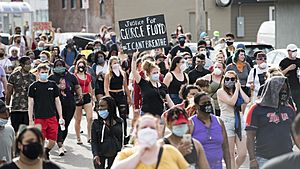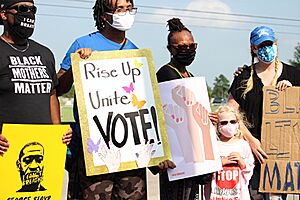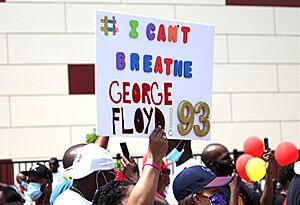Murder of George Floyd facts for kids
Quick facts for kids Murder of George Floyd |
|
|---|---|

Frame from witness video, showing Derek Chauvin kneeling on George Floyd's neck
|
|
| Location | Minneapolis, Minnesota, U.S. |
| Coordinates | 44°56′04″N 93°15′45″W / 44.93433°N 93.26244°W |
| Date | May 25, 2020; 5 years ago c. 8:01–9:25 pm CDT (UTC−5) |
| Victim | George Perry Floyd Jr. |
| Perpetrators |
|
On May 25, 2020, George Floyd, a 46-year-old Black American man, died in Minneapolis. A police officer named Derek Chauvin was involved. Floyd had been arrested because a store clerk said he used a fake $20 bill.
Chauvin knelt on Floyd's neck for over nine minutes. Floyd was handcuffed and lying face-down on the street. Two other police officers, J. Alexander Kueng and Thomas Lane, helped Chauvin hold Floyd down. A fourth officer, Tou Thao, stopped people nearby from helping.
Before being held on the ground, Floyd said he felt anxious and couldn't breathe. He also said he had claustrophobia, which is a fear of small spaces. While being held, he kept saying he couldn't breathe and was afraid he would die. After several minutes, Floyd stopped talking and moving. An officer checked but found no pulse. Even so, Chauvin did not move his knee from Floyd's neck.
The next day, videos from witnesses and security cameras became public. The Minneapolis Police Department fired all four officers. Later, medical examinations found that Floyd's death was a homicide, meaning it was caused by another person.
On March 12, 2021, Minneapolis agreed to pay $27 million to Floyd's family. This was to settle a lawsuit about his death. On April 20, Chauvin was found guilty of several charges related to Floyd's death. On June 25, he was sentenced to 22 and a half years in prison.
All four officers also faced federal charges for violating Floyd's civil rights. In December 2021, Chauvin admitted he violated Floyd's civil rights. He admitted to using too much force and ignoring Floyd's serious medical problems. The other three officers were also found guilty of violating Floyd's civil rights.
Lane admitted guilt in May 2022 to a state charge of helping in the death. He was sentenced to three years in prison. Kueng admitted guilt in October 2022 to helping in the death. He was sentenced to three and a half years in prison. Thao was found guilty of helping in the death in May 2023. He was sentenced to four and three-quarter years in prison.
Floyd's death led to protests around the world. People protested against police brutality, police racism, and the lack of police accountability.
Contents
Public Reaction
Protests for Justice

Floyd's death started a huge protest movement worldwide. People protested against racism and police violence. In the United States, these protests were the largest since the 1960s Civil Rights movement.
Protests began in Minneapolis–Saint Paul on May 26. Within days, they spread across the United States and to over 60 other countries. Many people supported the Black Lives Matter movement. By June 13, over 2,000 cities in the U.S. had seen demonstrations.
Many protests included "die-ins." Protesters would lie down for 8 minutes and 46 seconds. This was the time first reported that Chauvin knelt on Floyd's neck. Most protests were peaceful. However, some demonstrations turned into riots and looting. Some also saw clashes with police and significant police brutality. This was especially true against peaceful protesters and reporters.
By June 3, at least 200 U.S. cities had curfews. More than 30 states and Washington, D.C., called in over 62,000 National Guard members. This was due to the widespread unrest.
Initially, protests were peaceful. But later, some stores were damaged. At the 3rd Precinct police station in Minneapolis, windows were broken. A fence was pulled down, and the front entrance was broken into. Police officers fired less-than-lethal rounds at the crowd. After staff left the building, it was set on fire. A large apartment building being built also burned.
Police in riot gear used tear gas, flash grenades, rubber bullets, and smoke bombs. Some protesters threw rocks at the police. Many people noticed how police reacted differently to these protests. They seemed more aggressive than during earlier protests where white protesters carried guns. This idea spread on social media, especially by groups like Black Lives Matter.
Peaceful protests continued, but some turned violent after dark. This pattern repeated for several days. More than 1,500 businesses in the Minneapolis–Saint Paul area were damaged or destroyed. 67 of them were destroyed by fire.
After the rioting, a nighttime curfew was set for Minneapolis–Saint Paul and Dakota County on May 29. 500 Minnesota National Guard soldiers were sent to enforce the curfew. However, about 1,000 protesters marched peacefully on Interstate 35 well past curfew.
Mass protests demanding justice for George Floyd happened in over 2,000 cities worldwide. By May 30, 12 U.S. states called up the National Guard. At least 12 major cities had curfews that weekend. By June 14, protests continued for a third week in many cities. People also called for changes and less funding for police departments across the United States.
Remembering George Floyd

The area where Floyd died became a memorial on May 26. Many signs honored him and mentioned the Black Lives Matter movement. As the day went on, more people came to protest. Hundreds marched to the 3rd Precinct of the Minneapolis Police. They used posters and shouted phrases like "Justice for George," "I can't breathe," and "Black Lives Matter."
On September 18, the Minneapolis City Council named the street section where he died "George Perry Floyd Jr. Place." The intersection where it happened has been closed. Protesters have stayed there, saying they will not leave until their demands for anti-racism and property tax are met.
A public memorial was held on June 4 in Minneapolis. Al Sharpton gave a speech. A public viewing and family memorial took place in Raeford, North Carolina on June 6, near Floyd's hometown. Floyd's family held a public memorial in Houston on June 8, and a private service on June 9. The family said boxer Floyd Mayweather paid for the services.
Floyd's body was on public view in Houston on June 8. Former Vice President Joe Biden met with the Floyd family privately. He also gave a video message at the funeral. Floyd is buried next to his mother in Pearland, Texas.
The time Chauvin was first reported to have knelt on Floyd's neck, 8:46, became a symbol. It was used for "moments of silence" to honor Floyd. It was also used in chants, protest signs, and messages, as were the words "I can't breathe."
What Happened Next
Media Coverage
Darnella Frazier, who was 17, filmed Floyd's restraint on her cell phone. She received the 2020 PEN/Benenson Courage Award. This award was given to her in December 2020 by film director Spike Lee. The CEO of PEN America said Frazier's video started a "bold movement" against racism and police violence. In June 2021, Frazier also received a special award from the Pulitzer Prize committee for her video. The staff of the Star Tribune newspaper won a Pulitzer Prize for their reporting on the protests.
Changes in Policing
After Floyd's death, many states made changes to police rules. At least 17 state legislatures banned or limited chokeholds and other neck restraints. In some states, police disciplinary records became public. This means people can now see if officers have been disciplined before.
Justice Department Review
Because of Floyd's death, the United States Justice Department reviewed the Minneapolis Police Department. Their report, released in 2023, found that the city's police often used too much force. They also found that police stopped and searched Black and Native American people more often. The report said police violated the free-speech rights of protesters. They also discriminated against people with mental health issues during emergencies. Attorney General Merrick Garland said that these patterns "made what happened to George Floyd possible."
See also
 In Spanish: Muerte de George Floyd para niños
In Spanish: Muerte de George Floyd para niños


